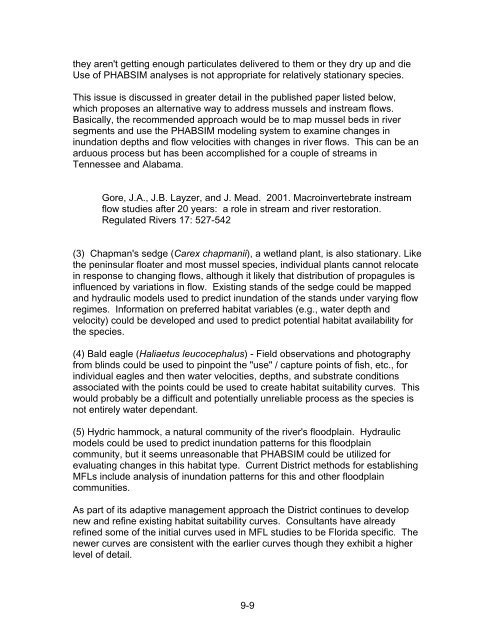Chapter 1 Minimum Flows and Levels - Southwest Florida Water ...
Chapter 1 Minimum Flows and Levels - Southwest Florida Water ...
Chapter 1 Minimum Flows and Levels - Southwest Florida Water ...
You also want an ePaper? Increase the reach of your titles
YUMPU automatically turns print PDFs into web optimized ePapers that Google loves.
they aren't getting enough particulates delivered to them or they dry up <strong>and</strong> die<br />
Use of PHABSIM analyses is not appropriate for relatively stationary species.<br />
This issue is discussed in greater detail in the published paper listed below,<br />
which proposes an alternative way to address mussels <strong>and</strong> instream flows.<br />
Basically, the recommended approach would be to map mussel beds in river<br />
segments <strong>and</strong> use the PHABSIM modeling system to examine changes in<br />
inundation depths <strong>and</strong> flow velocities with changes in river flows. This can be an<br />
arduous process but has been accomplished for a couple of streams in<br />
Tennessee <strong>and</strong> Alabama.<br />
Gore, J.A., J.B. Layzer, <strong>and</strong> J. Mead. 2001. Macroinvertebrate instream<br />
flow studies after 20 years: a role in stream <strong>and</strong> river restoration.<br />
Regulated Rivers 17: 527-542<br />
(3) Chapman's sedge (Carex chapmanii), a wetl<strong>and</strong> plant, is also stationary. Like<br />
the peninsular floater <strong>and</strong> most mussel species, individual plants cannot relocate<br />
in response to changing flows, although it likely that distribution of propagules is<br />
influenced by variations in flow. Existing st<strong>and</strong>s of the sedge could be mapped<br />
<strong>and</strong> hydraulic models used to predict inundation of the st<strong>and</strong>s under varying flow<br />
regimes. Information on preferred habitat variables (e.g., water depth <strong>and</strong><br />
velocity) could be developed <strong>and</strong> used to predict potential habitat availability for<br />
the species.<br />
(4) Bald eagle (Haliaetus leucocephalus) - Field observations <strong>and</strong> photography<br />
from blinds could be used to pinpoint the "use" / capture points of fish, etc., for<br />
individual eagles <strong>and</strong> then water velocities, depths, <strong>and</strong> substrate conditions<br />
associated with the points could be used to create habitat suitability curves. This<br />
would probably be a difficult <strong>and</strong> potentially unreliable process as the species is<br />
not entirely water dependant.<br />
(5) Hydric hammock, a natural community of the river's floodplain. Hydraulic<br />
models could be used to predict inundation patterns for this floodplain<br />
community, but it seems unreasonable that PHABSIM could be utilized for<br />
evaluating changes in this habitat type. Current District methods for establishing<br />
MFLs include analysis of inundation patterns for this <strong>and</strong> other floodplain<br />
communities.<br />
As part of its adaptive management approach the District continues to develop<br />
new <strong>and</strong> refine existing habitat suitability curves. Consultants have already<br />
refined some of the initial curves used in MFL studies to be <strong>Florida</strong> specific. The<br />
newer curves are consistent with the earlier curves though they exhibit a higher<br />
level of detail.<br />
9-9
















